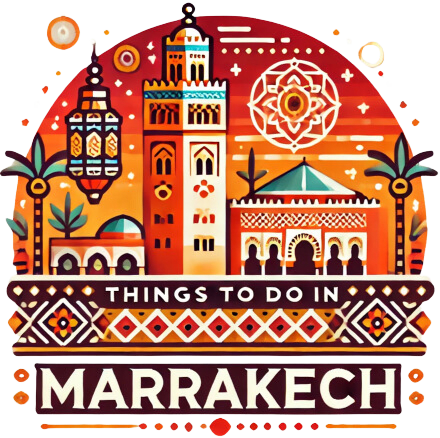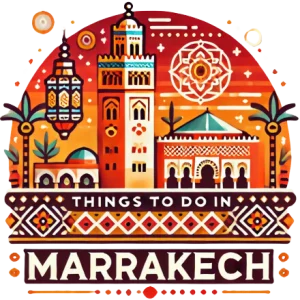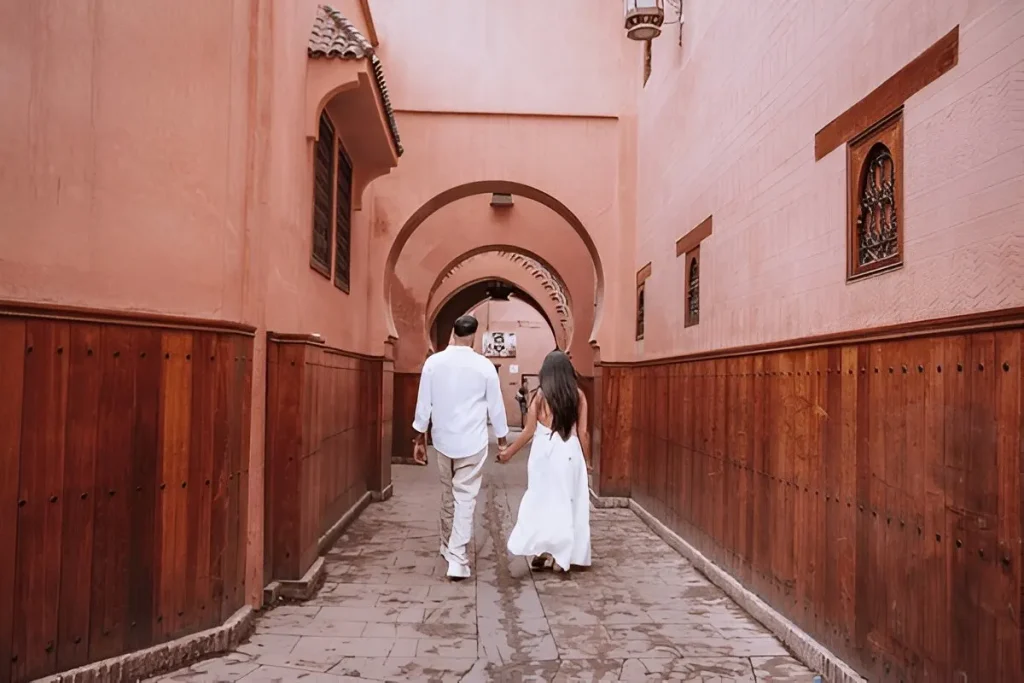From the moment you step into Marrakech, you’re enveloped by an explosion of culture, history, and sensory experiences. The places to see in Marrakech are as diverse as the city itself, blending ancient traditions with modern vibrance. The aroma of freshly baked bread from street vendors, the rhythmic beats of Gnawa musicians, and the mesmerizing sight of snake charmers all come together to create a unique tapestry of life. Whether you’re exploring bustling souks, majestic palaces, or serene gardens, every corner of the city holds a story waiting to be discovered.
As one of the most visited cities in Morocco, Marrakech offers an unparalleled blend of architectural wonders, lively markets, and serene gardens. Whether you’re exploring centuries-old palaces, sipping mint tea in a hidden riad, or haggling for souvenirs in the bustling souks, every moment in this city feels like stepping into a storybook.
To make the most of your 2025 trip, we’ve compiled a list of 15 must-visit places in Marrakech that will leave you in awe.
Table of Contents
1. Jemaa el-Fnaa – The Beating Heart of Marrakech

Jemaa el-Fnaa is not just a square; it’s an ever-changing spectacle of Moroccan culture. By day, vendors offer fresh orange juice, dried fruits, and aromatic spices. By night, the square transforms into a festival of lights, sounds, and flavors, with street performers, storytellers, and food stalls taking over.
- Watch traditional Moroccan storytellers and musicians bring ancient tales to life.
- Try local delicacies such as grilled lamb skewers and snail soup.
- Capture stunning sunset views from a rooftop café overlooking the square.
📍 Location: Medina, Marrakech
2. The Majorelle Garden – A Botanical Paradise
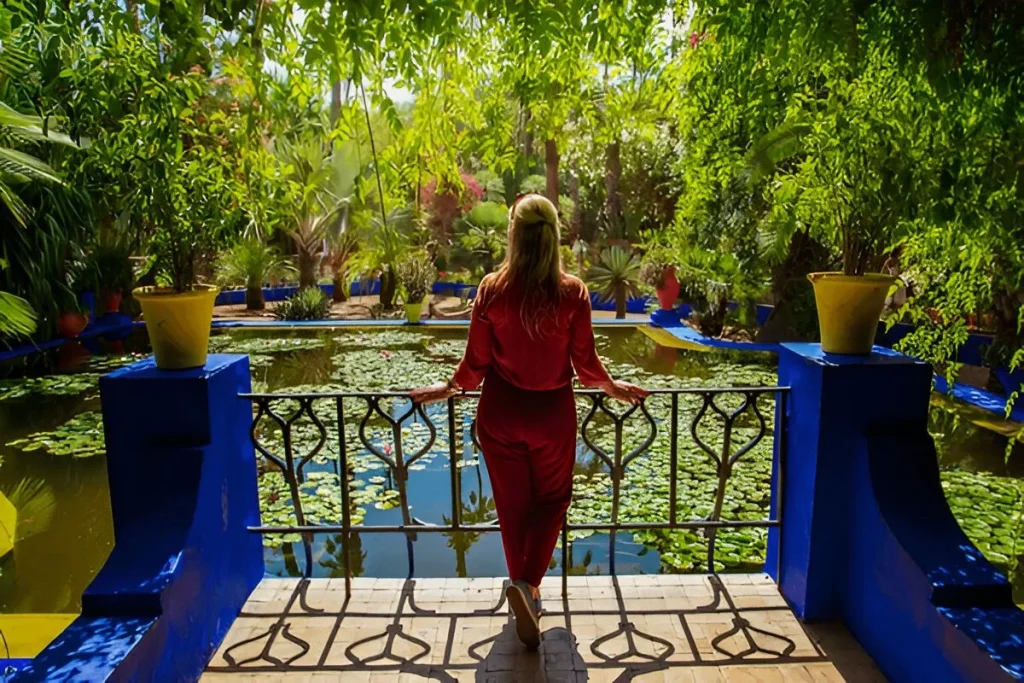
Designed by French artist Jacques Majorelle in the 1920s and later restored by Yves Saint Laurent, this lush oasis is a visual masterpiece. Vibrant cobalt blue walls contrast with towering cacti and exotic plants from around the world.
- Visit early in the morning to avoid the crowds and capture the best photos.
- Explore the Berber Museum, which showcases the rich cultural heritage of Morocco’s indigenous people.
- Relax with a cup of Moroccan mint tea at the garden’s chic café.
📍 Location: Gueliz, Marrakech
3. The Koutoubia Mosque – The Symbol of Marrakech
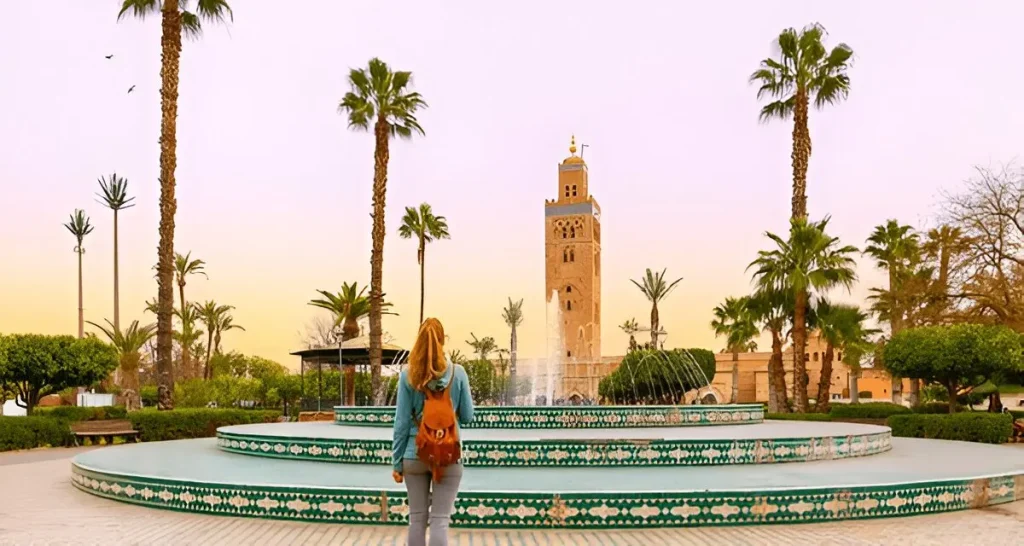
Standing tall at 77 meters, theKoutoubia Mosque is the largest and most iconic mosque in Marrakech. Built in the 12th century, its stunning minaret has inspired the designs of many mosques across North Africa and Spain.
Non-Muslims cannot enter, but the beautifully landscaped gardens surrounding the mosque provide a serene spot for relaxation.
4. Bahia Palace – A Glimpse into Moroccan Royalty
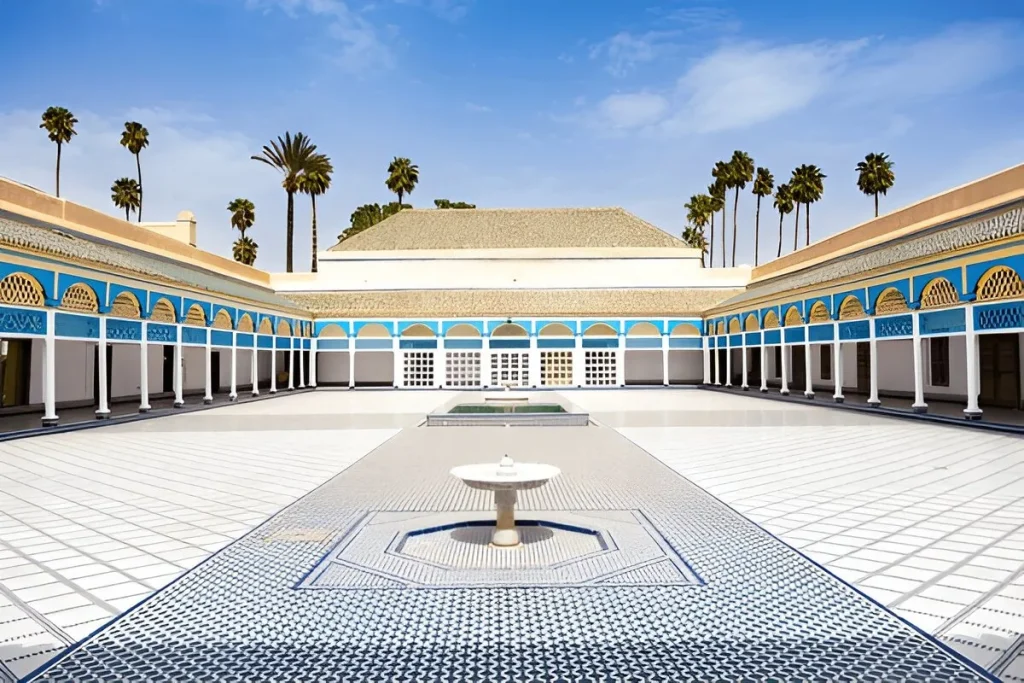
Step inside the Bahia Palace, and you’ll feel as though you’ve traveled back in time to an era of grandeur and refinement. Built in the late 19th century, this palace was designed to be the most magnificent residence in Marrakech, a symbol of wealth and power for the grand vizier Si Moussa. Every inch of this architectural masterpiece reflects the artistry and craftsmanship of Moroccan builders, with intricate stucco carvings, hand-painted cedarwood ceilings, and colorful zellige tilework that stretches across vast courtyards.
As you walk through its passageways, you’ll find yourself surrounded by serene gardens filled with the scent of orange blossoms and jasmine. This stunning landmark is one of the must-visit places to see in Marrakech, offering a glimpse into the grandeur of Morocco’s past. The palace’s Riad-style layout creates a sense of tranquility, with fountains gently trickling in the background, offering a cool retreat from the city’s bustling streets. Each hall and chamber tells a silent story—of royal gatherings, whispered conversations in shaded alcoves, and the opulent lives of those who once resided here.
The Grand Courtyard, one of the palace’s most breathtaking spaces, is a marvel of symmetry and detail. Covered in marble and surrounded by carved wooden galleries, it was once the heart of lavish receptions and celebrations. Beyond the courtyards, you’ll find rooms decorated with stained glass windows that cast colorful reflections on the polished floors, enhancing the mystical atmosphere of the palace.
Unlike some of Marrakech’s royal residences, Bahia Palace is not a relic of ruins—it remains beautifully preserved, offering visitors a rare glimpse into Morocco’s aristocratic past. As you explore its rooms, you can almost imagine the sound of footsteps echoing off the walls, the soft murmur of voices drifting through the corridors, and the gentle rustling of silk robes in the breeze.
A visit to Bahia Palace isn’t just about admiring its beauty; it’s about experiencing the artistry and soul that went into every detail. It’s a place where history lingers in the air, waiting for you to uncover its secrets.
Highlights:
- Marvel at the stunning mosaic-tiled ceilings and carved wooden doors.
- Wander through the tranquil gardens, once a retreat for the royal family.
- Learn about Moroccan history and palace life through guided tours.
🎟️ Entry Fee: 70 MAD
5. Saadian Tombs – A Hidden Historical Treasure
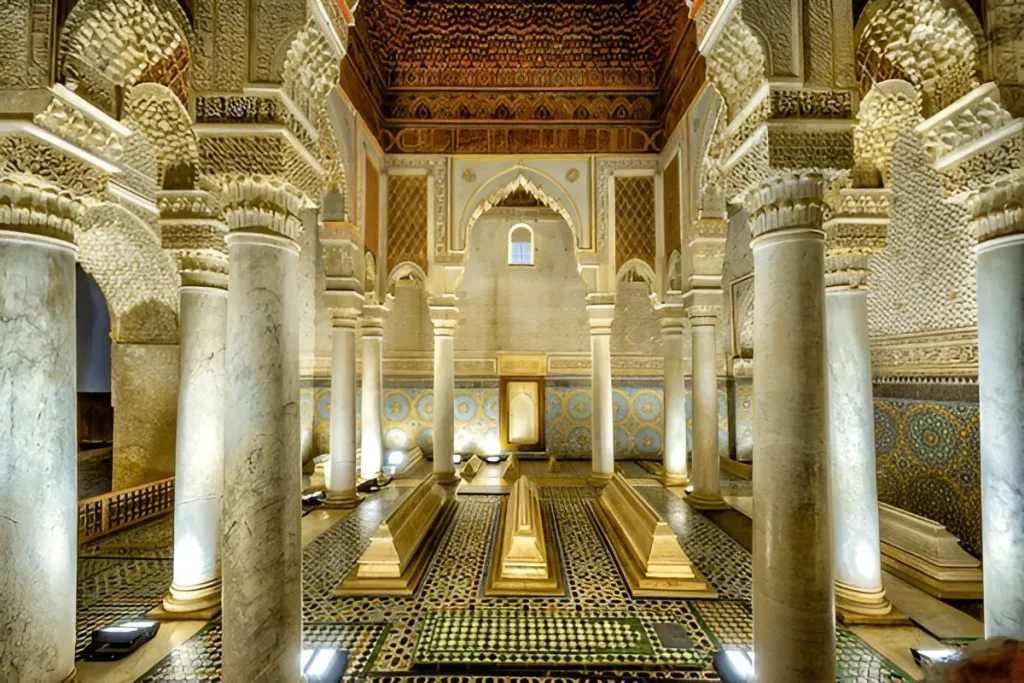
For centuries, the Saadian Tombs remained sealed away, their existence almost forgotten, hidden behind the high walls of the Kasbah Mosque. It wasn’t until 1917, when aerial photography uncovered their location, that these tombs were finally brought back into the public eye. Stepping inside today, you’ll find yourself face to face with one of Marrakech’s most breathtaking historical sites—a silent resting place that tells the story of an era defined by power, artistry, and grandeur.
This sacred burial ground is the final resting place of Sultan Ahmad al-Mansur, the ruler who led Morocco into a golden age of wealth and influence during the late 16th century. Alongside him, members of his royal family and trusted advisors were laid to rest, their tombs adorned with Italian Carrara marble, delicate cedarwood carvings, and intricate zellige tilework. Unlike the stark simplicity of many Moroccan graves, the Saadian Tombs reflect the sultan’s desire for everlasting prestige, showcasing the finest craftsmanship of the time.
The most striking section is the Chamber of the Twelve Columns, where Sultan al-Mansur himself is buried. This breathtaking site stands out among the places to see in Marrakech, offering a glimpse into the city’s rich history and architectural brilliance. Sunlight filters through finely carved openings, casting soft patterns across the polished marble, enhancing the chamber’s ethereal atmosphere. Above, an intricately decorated muqarnas ceiling, a hallmark of Moroccan and Andalusian architecture, draws your gaze upward, revealing an astonishing level of detail that has withstood the passage of time.
Outside, a tranquil garden surrounds the tombs, creating a peaceful retreat from the lively streets of the Medina. Birds flit between the orange trees, and the air is filled with a quiet reverence, as visitors walk softly along the stone paths, absorbing the weight of history that lingers in the air.
Unlike many royal sites that have crumbled with time, the Saadian Tombs remain remarkably well-preserved, thanks to the quality of their original construction and their centuries-long concealment. Today, they stand as a testament to the artistic and architectural brilliance of the Saadian era, inviting you to step into a forgotten chapter of Morocco’s past—one that, for generations, remained hidden just beyond reach.
Visit early in the day to avoid long queues, as this site attracts many history enthusiasts.
6. The Medina Souks – A Shopper’s Paradise
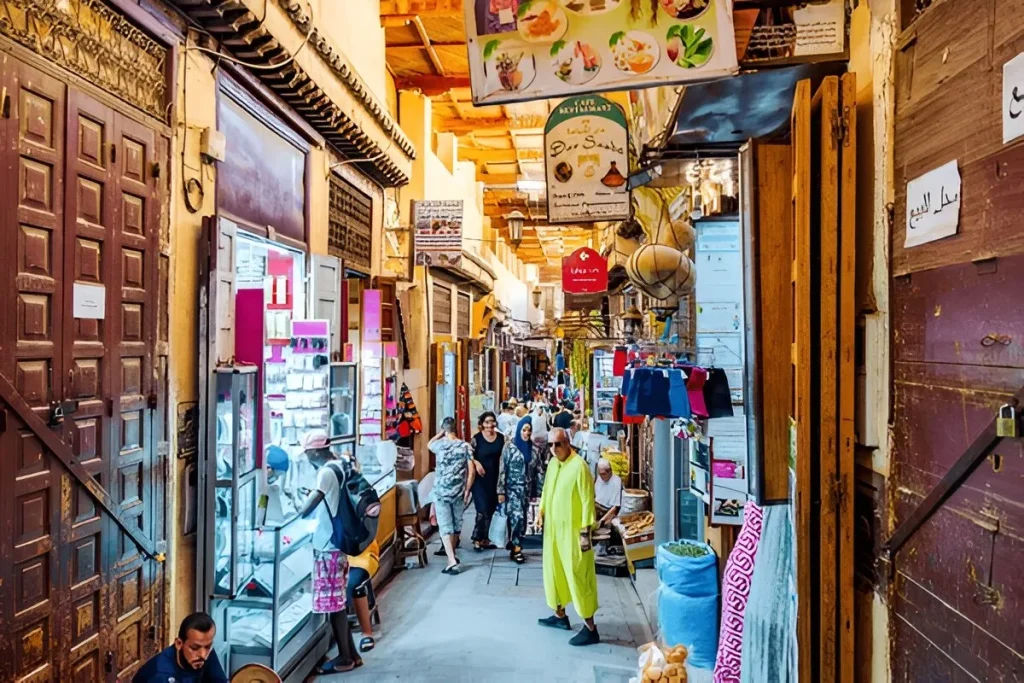
The souks of Marrakech are a world of their own—a maze of winding alleyways where the air is thick with the scent of spices, the chatter of bargaining voices, and the rhythmic hammering of artisans at work. These bustling markets have been the lifeblood of the city for centuries, drawing traders, craftsmen, and explorers from across North Africa and beyond. Whether you’re searching for a one-of-a-kind souvenir, an authentic Moroccan rug, or simply the thrill of getting lost in the vibrant chaos, the souks are a place where every turn holds something unexpected.
As you step inside, you’ll find yourself surrounded by a sensory overload. Brightly colored Berber carpets hang from shopfronts, shimmering lanterns cast intricate patterns on the walls, and the sweet, earthy aroma of cinnamon, cumin, and saffron fills the air. Leather babouches (traditional slippers) line the stalls in every shade imaginable, while skilled artisans carefully engrave intricate designs into brass trays, their hands moving with the precision of generations before them.
Haggling here isn’t just a transaction—it’s a time-honored tradition. Vendors expect you to negotiate, and the dance of bargaining is part of the fun. The key is confidence, patience, and a friendly smile. Start with a counteroffer at half the asking price, engage in a little lighthearted banter, and before you know it, you’ll be shaking hands on a deal that feels like a victory.
Each section of the souk has its own specialty, making it one of the most exciting places to see in Marrakech for those who love shopping and craftsmanship. If you’re looking for handwoven textiles and embroidered fabrics, head to Souk des Tapis, where merchants display vibrant rugs stacked high against the walls. For those drawn to the irresistible scent of freshly ground spices, Souk El Attarine is the place to go, with its mounds of saffron, argan oil, and ras el hanout—a signature Moroccan spice blend. In Souk Haddadine, blacksmiths shape iron into ornate lanterns and furniture, while Souk Cherratine is home to master leatherworkers crafting bags, belts, and poufs from the finest hides.
Despite the lively energy, there are moments of calm hidden within the chaos. Tucked between the bustling stalls, you’ll find tiny courtyard cafés where you can pause for a glass of refreshing mint tea. Sit back, listen to the distant echoes of musicians playing their stringed guembris, and watch the dance of daily life unfold before your eyes.
Navigating the souks is an adventure in itself. Maps won’t help much here—your best guide is curiosity. Allow yourself to get lost, follow the scent of freshly baked msemen (Moroccan pancakes), and trust that every wrong turn might just lead to your next great discovery. One thing is certain: in the souks of Marrakech, you don’t just shop—you experience.
Best Souks to Explore:
- Souk Semmarine: Famous for textiles, rugs, and lamps.
- Souk El Attarine: Best place to buy spices and perfumes.
- Souk Haddadine: Specializes in metalwork and blacksmithing.
7. Ben Youssef Madrasa – A Masterpiece of Islamic Architecture
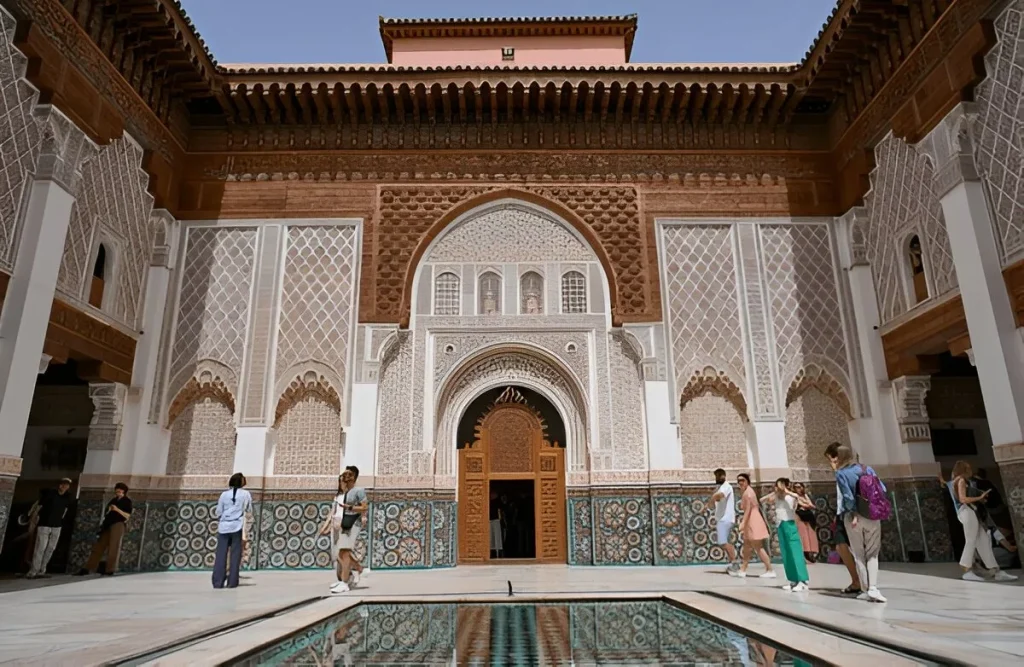
Once the largest Islamic school in North Africa, Ben Youssef Madrasa stands as a breathtaking testament to the artistic and intellectual grandeur of Marrakech’s past. Founded in the 14th century and later expanded by the Saadian dynasty, this madrasa once housed up to 900 students, all gathered here in pursuit of religious and academic knowledge. Walking through its doors today, you can almost hear the echoes of Quranic recitations that once filled these halls, a reminder of its vibrant past as a center of learning.
As you step inside, your eyes are immediately drawn to the intricate Moorish architecture that makes this place so mesmerizing. The walls are adorned with finely carved zellige tile mosaics, their geometric patterns forming a dazzling interplay of colors and shapes. Above, delicate cedarwood latticework filters the sunlight, casting beautiful shadows across the stone floors. Arabic calligraphy, meticulously etched into the stucco, adorns the walls with verses from the Quran, each inscription a piece of spiritual artistry frozen in time.
The heart of the madrasa is its serene courtyard, a sanctuary of calm amidst the city’s bustling Medina. At its center, a marble water basin reflects the sky, a feature that once served as a place of ritual purification for students before prayer. Surrounding it, towering horseshoe arches and meticulously carved doorways lead to the students’ former dormitories—tiny, windowless rooms that stand in stark contrast to the grandeur of the public spaces. These quarters, though simple, once held the dreams and aspirations of scholars from across the region who came here to study theology, law, astronomy, and mathematics.
One of the most captivating details of Ben Youssef Madrasa, one of the must-visit places to see in Marrakech, is its muqarnas ceiling, a marvel of Moroccan craftsmanship. This honeycomb-like architectural feature, made up of hundreds of intricately shaped plaster formations, creates a mesmerizing three-dimensional effect that leaves visitors in awe. It’s the kind of detail that reveals itself the longer you look, making you appreciate the dedication of the artisans who crafted it centuries ago.
Despite closing as a religious school in 1960, Ben Youssef Madrasa has been carefully restored, allowing visitors to step into a world where history, spirituality, and artistry intertwine. Whether you’re fascinated by Islamic architecture, drawn to Morocco’s rich history, or simply seeking a quiet place to admire breathtaking craftsmanship, this madrasa is a must-visit. Here, you don’t just witness history—you feel it in every carved archway, every tiled wall, and every whisper of the past that lingers in the air.
8. Le Jardin Secret – A Tranquil Escape in the Medina
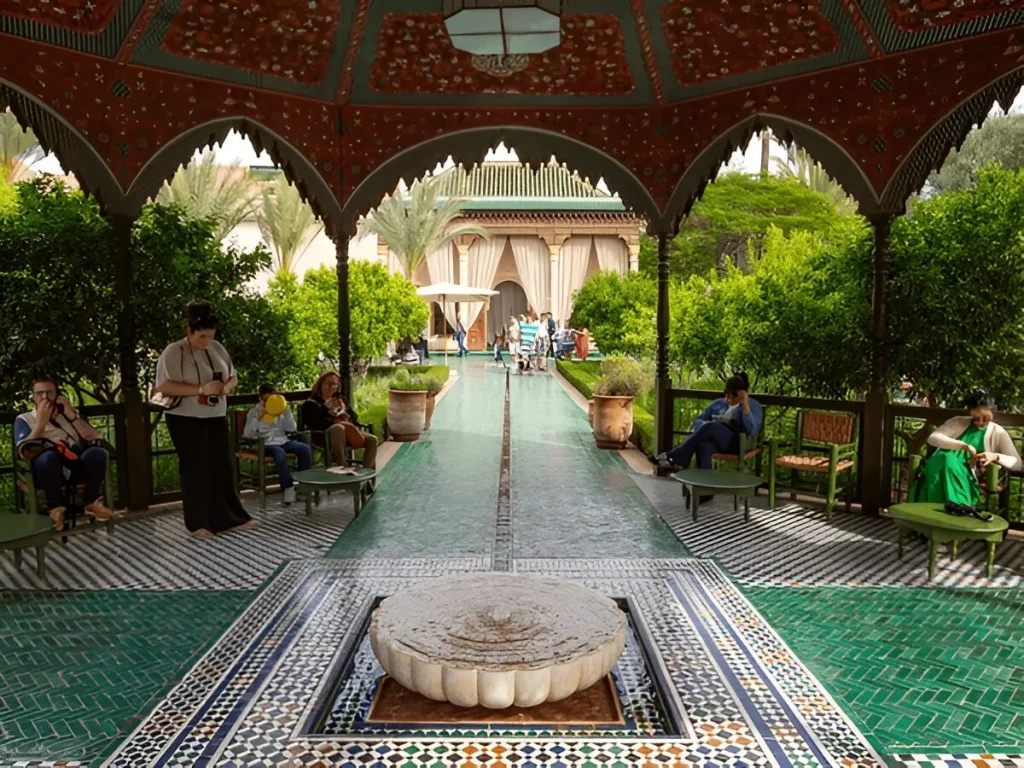
Tucked away in the heart of the Medina, Le Jardin Secret is a hidden gem that transports you into a world of peace and natural beauty. Dating back over 400 years, this restored botanical haven was once a private garden belonging to an influential palace. Today, it stands as a stunning example of Islamic garden design, blending architecture, water features, and lush greenery to create an oasis of calm amidst the city’s energetic streets.
Unlike the famous Majorelle Garden, which often draws large crowds, Le Jardin Secret offers a more intimate experience. As you step through its unassuming entrance, the contrast between the bustling souks outside and the tranquility within is almost surreal. The air is noticeably cooler, filled with the scent of citrus trees, fresh herbs, and blooming jasmine. The sound of trickling fountains provides a soothing backdrop as you wander along the stone pathways, passing through beautifully landscaped sections inspired by traditional Moroccan riads.
One of the most captivating features of Le Jardin Secret, one of the most tranquil places to see in Marrakech, is its perfectly preserved irrigation system, a testament to the ingenuity of ancient Moroccan engineering. Water, considered a sacred element in Islamic culture, flows effortlessly through the garden’s network of small canals and fountains, nourishing a diverse collection of exotic plants from around the world. Olive trees stand alongside rare palms, while fragrant rosemary and lavender bushes add to the sensory experience.
For the best view, make your way to the watchtower, a unique feature that sets this garden apart. Climbing to the top rewards you with a panoramic view of Marrakech’s rooftops, with the towering Koutoubia Mosque dominating the skyline. From this vantage point, you can truly appreciate the contrast between the city’s maze-like alleyways and the serenity of the garden below.
Beyond its beauty, Le Jardin Secret is a place where history and nature intertwine. It offers a glimpse into the elegant lifestyle of Marrakech’s aristocracy from centuries past, where gardens weren’t just decorative but essential retreats for reflection and relaxation. Whether you’re seeking a peaceful escape, a spot for quiet contemplation, or simply a breathtaking view of the city, this secret sanctuary is a must-visit.
9. The Mellah – The Historic Jewish Quarter
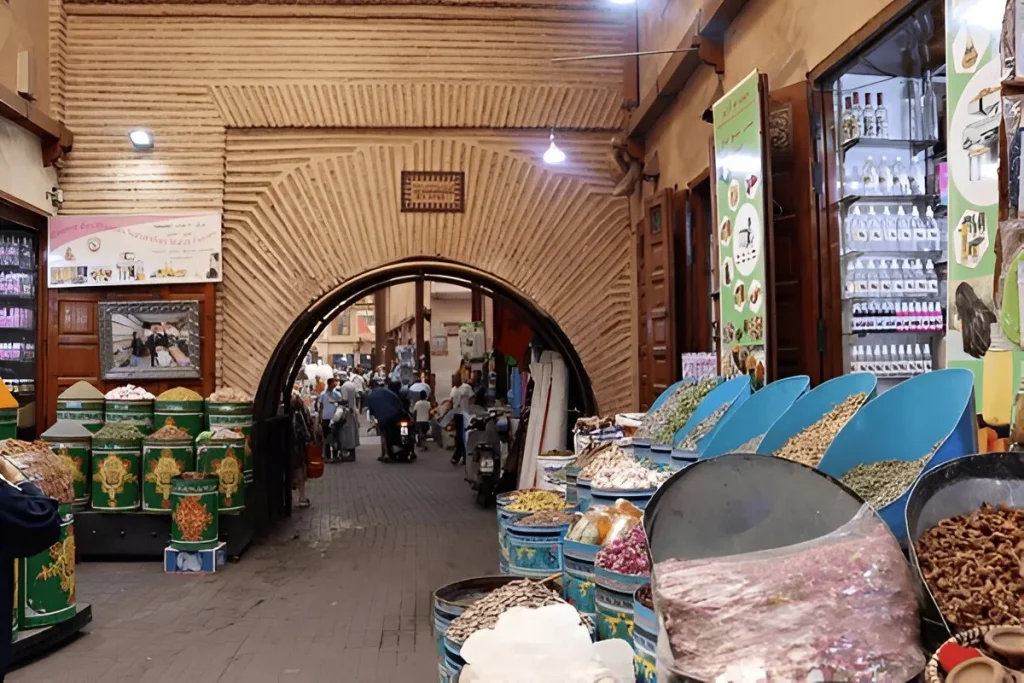
- Explore the Lazama Synagogue, one of the oldest in Morocco.
- Visit the Jewish Cemetery, a place of deep historical significance.
10. El Badi Palace – The Once-Glorious Royal Residence
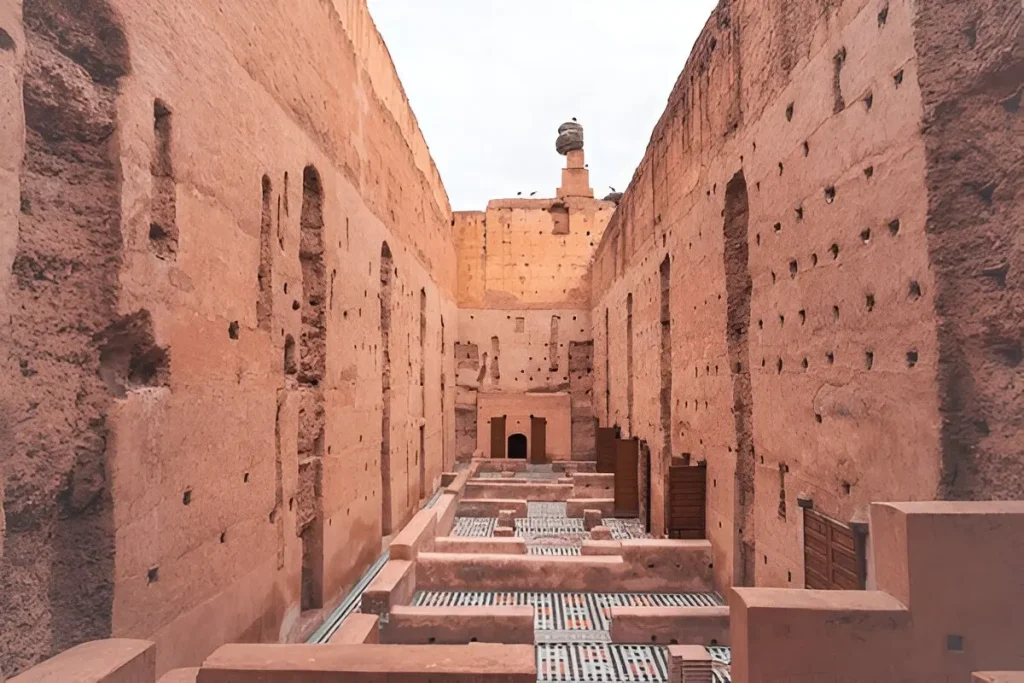
Once considered the “eighth wonder of the world,” the El Badi Palace was a masterpiece of opulence and power, designed to showcase the wealth and ambition of Sultan Ahmad al-Mansur of the Saadian dynasty. Built in the late 16th century, this grand palace was constructed using the finest materials available—Italian marble, Sudanese gold, Indian onyx, and intricately carved cedarwood from the Atlas Mountains. It stood as a testament to Morocco’s golden age, a dazzling display of artistry meant to rival the most magnificent palaces of its time.
Although now in ruins, the sheer scale of El Badi Palace is still awe-inspiring. As you walk through its remains, it’s easy to imagine the grandeur that once defined these walls. The palace was once home to 360 lavishly decorated rooms, expansive courtyards lined with sunken gardens, and massive reflecting pools that shimmered under the Moroccan sun. It served as the sultan’s royal residence, a place where foreign dignitaries were entertained in extravagant fashion, surrounded by fountains, mosaics, and the scent of citrus trees perfuming the air.
However, its splendor was short-lived. Following the fall of the Saadian dynasty, the succeeding Alaouite ruler, Sultan Moulay Ismail, ordered the palace to be dismantled in the late 17th century. Its materials were stripped and repurposed for the construction of his new imperial city in Meknes, leaving El Badi as little more than a skeleton of its former self. What was once a symbol of unmatched luxury became an abandoned ruin, standing as a silent witness to Morocco’s shifting tides of power.
Despite its faded glory, El Badi Palace still captivates visitors today and remains one of the most fascinating places to see in Marrakech. Walking through its vast courtyards, you can stand at the edge of the immense sunken gardens, where trees once provided shade to the sultan’s guests. The high-walled terraces offer sweeping views of the Medina, and the stork nests perched along the crumbling walls add a strangely poetic charm to the site. It’s a place where history lingers in every shadow, where the echoes of past grandeur still whisper through the ruins.
For those with a love of history and architecture, El Badi Palace is more than just a collection of ancient stones—it’s a story of ambition, rise, and downfall, a place that invites you to imagine the lavish celebrations that once took place here and to appreciate the enduring legacy of Marrakech’s royal past.
11. House of Photography – A Visual Journey Through Time
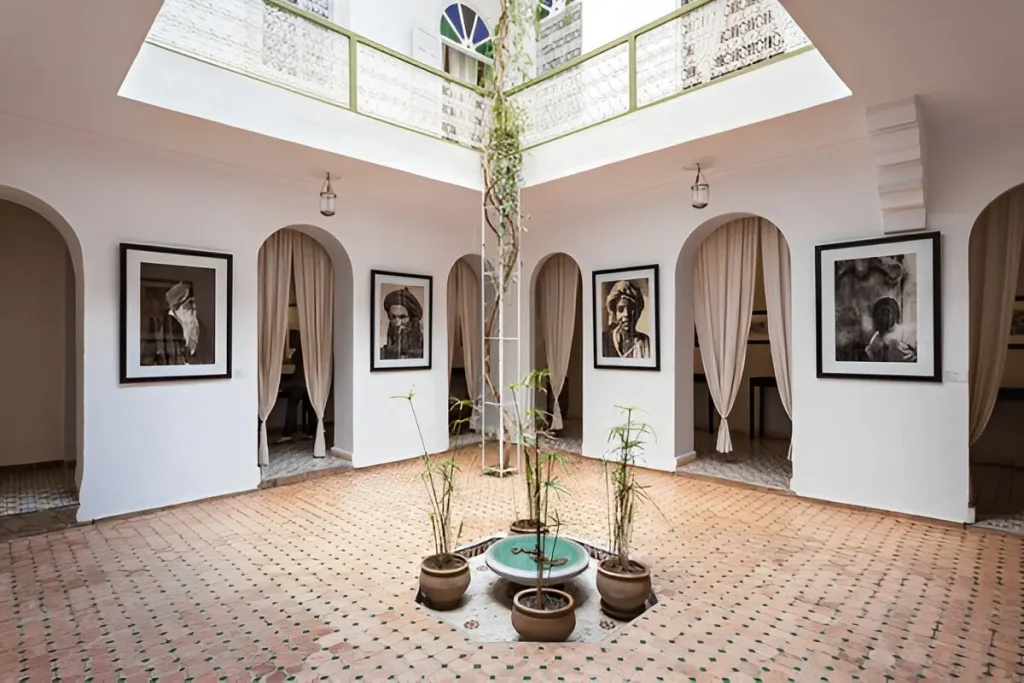
Tucked away in the heart of the Medina, the House of Photography of Marrakech (Maison de la Photographie) is more than just a museum—it’s a window into Morocco’s past, capturing the essence of a country in transition. This beautifully curated collection of rare photographs, dating from the late 19th to mid-20th century, offers an intimate and evocative journey through time, bringing to life the landscapes, faces, and traditions that have shaped Moroccan identity.
As you step inside, you’re immediately transported to an era before modern roads and bustling tourist markets, a time when Morocco’s cities were still deeply rooted in their ancient ways. The museum’s collection includes over 10,000 photographs, covering everything from daily life in remote Berber villages to the grand architecture of Marrakech’s palaces and mosques. Each image tells a silent yet powerful story—whether it’s a portrait of a dignified Tuareg nomad standing in the Sahara, a bustling souk scene frozen in time, or a candid glimpse of Moroccan women in traditional dress, their expressions filled with mystery and resilience.
Beyond photographs, the museum also features an array of early travel postcards, glass negatives, and vintage films, offering an even richer perspective on how Morocco was viewed by both locals and foreign explorers. As one of the most intriguing places to see in Marrakech, this museum provides a deep dive into the country’s past through striking black-and-white images of the Atlas Mountains, portraits of Berber warriors, and scenes from Morocco’s once-thriving Jewish communities. Each piece reveals a side of the country that modern visitors rarely get to see, making it a must-visit for history and photography enthusiasts alike.
One of the museum’s standout features is its rooftop terrace, which offers one of the most breathtaking panoramic views of Marrakech’s old city. After exploring the galleries, you can sit with a cup of traditional mint tea, gazing over the terracotta rooftops and minarets, taking in the same skyline that has been photographed for over a century.
Unlike larger, more commercial museums, the House of Photography feels personal, almost like stepping into a private collection curated with love and deep respect for Moroccan history. Whether you’re passionate about photography, fascinated by Morocco’s diverse cultural heritage, or simply looking for a unique and peaceful escape from the Medina’s hustle, this museum is an experience that stays with you long after you leave.
- Explore beautifully preserved photographs, postcards, and old films.
- Enjoy a cup of tea on the rooftop terrace with breathtaking views of the Medina.
- Great for photography enthusiasts and cultural explorers.
12. The Palmeraie – Marrakech’s Palm Oasis
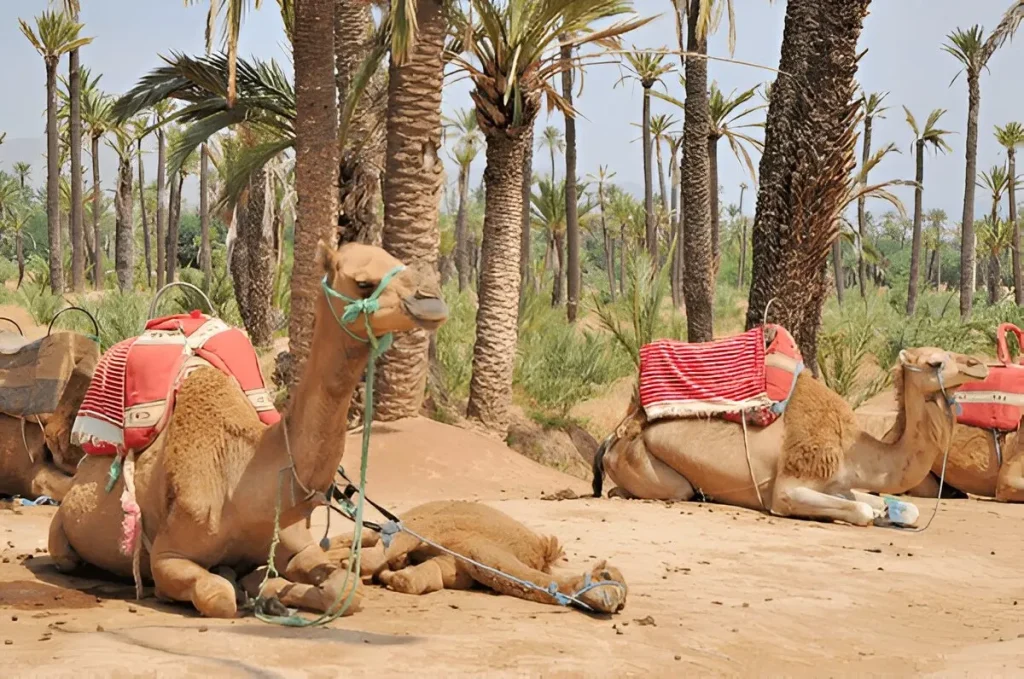
Just a short drive from the lively streets of Marrakech, the Palmeraie unfolds like a desert mirage—a vast palm grove stretching across thousands of hectares, offering a tranquil retreat from the city’s nonstop energy. This historic oasis, dotted with over 100,000 towering palm trees, is a place where nature, adventure, and tradition come together to create an unforgettable experience.
For centuries, the Palmeraie has played a vital role in Marrakech’s landscape, originally planted during the Almoravid dynasty as a source of shade, dates, and irrigation for the surrounding areas. Today, it serves as both a luxury getaway and an adventure hotspot, drawing visitors who seek something beyond the usual city experience.
One of the most iconic ways to explore the Palmeraie is on a camel ride, an experience that allows you to step back in time and see the desert landscape the way ancient traders once did. As you sway gently with the rhythm of your camel’s movements, you’ll pass clusters of palm trees, sandy trails, and glimpses of the distant Atlas Mountains. It’s the kind of moment that makes you feel as if you’ve been transported to another era, where caravans once roamed these lands, carrying spices and treasures from distant corners of the world.
If you’re craving something more fast-paced, quad biking through the Palmeraie delivers an adrenaline-fueled adventure like no other. As one of the most exciting places to see in Marrakech, this vast palm oasis offers the perfect terrain for thrill-seekers. Feel the rush as you speed across rugged desert paths, kicking up clouds of dust as you weave between towering palms and rocky terrain. Guided tours take you deeper into the landscape, where you might encounter traditional Berber villages, hidden desert lodges, and even stretches of dry riverbeds where nature has left its mark over the centuries.
Beyond adventure, the Palmeraie is also home to luxury resorts, high-end spas, and golf courses, making it an ideal destination for relaxation. Many upscale hotels and villas are nestled within the grove, offering a secluded escape where you can lounge by the pool, indulge in a Moroccan hammam, or enjoy fine dining under the stars.
Whether you’re drawn to the thrill of exploration, the romance of a sunset camel trek, or the indulgence of a luxury retreat, the Palmeraie offers something for every traveler. It’s a place where you can trade the city’s hustle for open landscapes, where the rustling of palm leaves replaces the honking of traffic, and where the simple beauty of the desert reminds you to slow down and take it all in.
- Experience a traditional camel trek across the desert-like landscape.
- Enjoy a thrilling quad biking adventure through palm groves.
- Visit luxury resorts and golf courses nestled within the oasis.
13. Dar Si Said Museum – The Art of Moroccan Craftsmanship

Tucked away in the heart of Marrakech’s Medina, the Dar Si Said Museum is more than just a collection of artifacts—it’s a journey through Morocco’s deep-rooted artistic traditions, housed within one of the most breathtaking riads in the city. This former palace, once the home of Si Said, the brother of Grand Vizier Ba Ahmed (who built the Bahia Palace), is an architectural masterpiece in itself. With its elaborately carved wooden doors, painted cedar ceilings, and intricate zellige tilework, every corner of the building reflects the very craftsmanship it was designed to celebrate.
As you step inside, you’re immediately surrounded by an atmosphere of elegance and history. The museum’s collection spans centuries, featuring handwoven Berber carpets, intricate jewelry, delicately carved wooden furniture, and stunning examples of traditional Moroccan ceramics. These aren’t just decorative items—they tell the story of Moroccan craftsmanship, passed down through generations of skilled artisans. Each piece is a testament to the dedication, patience, and artistry that define Morocco’s cultural heritage.
One of the museum’s most impressive displays is its carpet collection, which showcases the distinct weaving styles of Morocco’s different regions. You’ll see bold geometric patterns from the Atlas Mountains, delicate embroidery from Fes, and vibrant, hand-knotted rugs from the Berber tribes of the Sahara. The skill and symbolism woven into each piece reflect the cultural identity of the people who created them, making each carpet not just a work of art, but a living piece of history.
Beyond textiles, the woodwork section is another highlight, displaying exquisitely carved cedarwood doors, chests, and ceilings that once adorned Moroccan palaces and riads. As one of the most culturally rich places to see in Marrakech, this museum showcases craftsmanship that reflects Morocco’s deep artistic heritage. The level of detail in each piece is astounding, with delicate arabesque patterns and inscriptions carefully etched by hand—a craft that has remained largely unchanged for centuries. Similarly, the jewelry collection dazzles with ornate silver and amber pieces, worn by Berber women as symbols of status and protection.
The courtyard garden at the heart of Dar Si Said Museum provides a serene break from the exhibits, allowing you to soak in the beauty of its fountain, orange trees, and peaceful surroundings. It’s easy to imagine what life was like when this space was a private residence, where members of the elite would gather to enjoy music, poetry, and the tranquility of their hidden sanctuary.
Visiting the Dar Si Said Museum isn’t just about admiring artifacts—it’s about experiencing Morocco’s artistic soul. Whether you’re fascinated by textiles, intrigued by centuries-old craftsmanship, or simply in awe of the country’s artistic heritage, this museum offers a deeper understanding of the skill, creativity, and cultural significance behind Moroccan art. Every piece has a story to tell, and within these walls, those stories come to life.
- Admire some of the finest Moroccan carpets ever made.
- Explore traditional Berber artifacts and intricate metalwork.
- Walk through a beautifully designed interior featuring elaborate wood carvings.
14. Agafay Desert – A Mini Sahara Near Marrakech
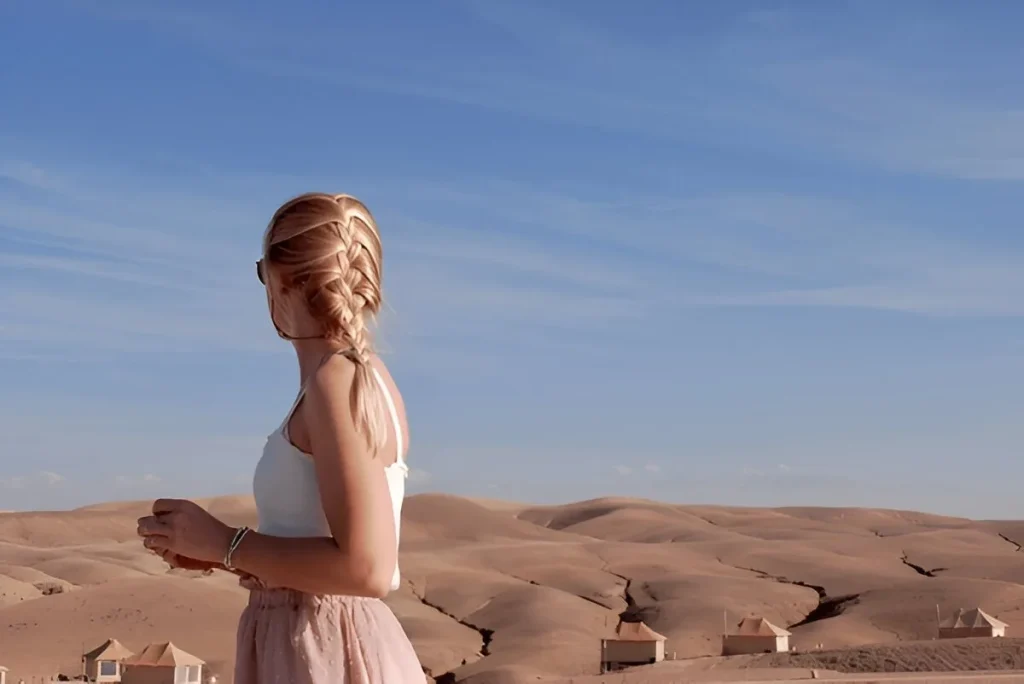
If you’re longing for the magic of the desert but don’t have time to travel all the way to the vast dunes of the Sahara, the Agafay Desert is the perfect solution. Just a 40-minute drive from Marrakech, this rocky, lunar-like expanse offers a completely different side of Morocco’s landscape—one that feels remote, untouched, and breathtakingly serene. Unlike the classic golden sand dunes often associated with Moroccan deserts, Agafay is a stone desert, where rolling hills, dry riverbeds, and rugged terrain stretch as far as the eye can see.
Despite its rocky nature, Agafay exudes an unmistakable desert charm. The changing light throughout the day paints the landscape in warm hues, shifting from soft beige in the morning to fiery gold at sunset. At night, under a blanket of thousands of twinkling stars, the desert transforms into a tranquil oasis, offering one of the most unforgettable stargazing experiences near Marrakech.
One of the best ways to experience Agafay is by staying at a luxury desert camp, where traditional Moroccan hospitality meets modern comfort. Imagine spending the night in a beautifully decorated Berber tent, complete with plush bedding, intricately woven carpets, and lanterns casting a warm glow. As the evening unfolds, you can enjoy a traditional Moroccan feast under the stars, accompanied by live Gnawa music and the rhythmic beats of the desert drum. The atmosphere is both mystical and intimate, making it an ideal retreat for couples, families, and solo travelers alike.
For adventure seekers, Agafay offers a variety of thrilling activities, making it one of the most exciting places to see in Marrakech. You can ride a camel across the rocky plains, following the ancient trade routes once traveled by caravans. If you’re looking for something more exhilarating, hop on a quad bike or a dune buggy, and race through the rugged landscape, kicking up dust as you go. For a more peaceful experience, try horseback riding at sunset, when the desert takes on a soft, golden glow, creating the perfect backdrop for an unforgettable ride.
Beyond the adrenaline-fueled adventures, the Agafay Desert is also home to hidden oases, where palm trees and small water sources create a surprising contrast to the arid surroundings. Some camps even offer desert yoga and meditation sessions, allowing you to fully embrace the tranquility of this magical place.
Unlike the long journey required to reach Merzouga or Erg Chebbi, the Agafay Desert offers a true Moroccan desert experience within easy reach of Marrakech. Whether you’re looking for adventure, relaxation, or a romantic getaway, Agafay delivers a once-in-a-lifetime escape, where time slows down, and the beauty of the Moroccan wilderness takes center stage.
- Stay in a luxury desert camp under a starlit sky.
- Enjoy camel riding, sandboarding, or a guided 4×4 tour.
- Have a traditional Moroccan dinner in the heart of the desert.
15. Atlas Mountains – A Scenic Day Trip from Marrakech
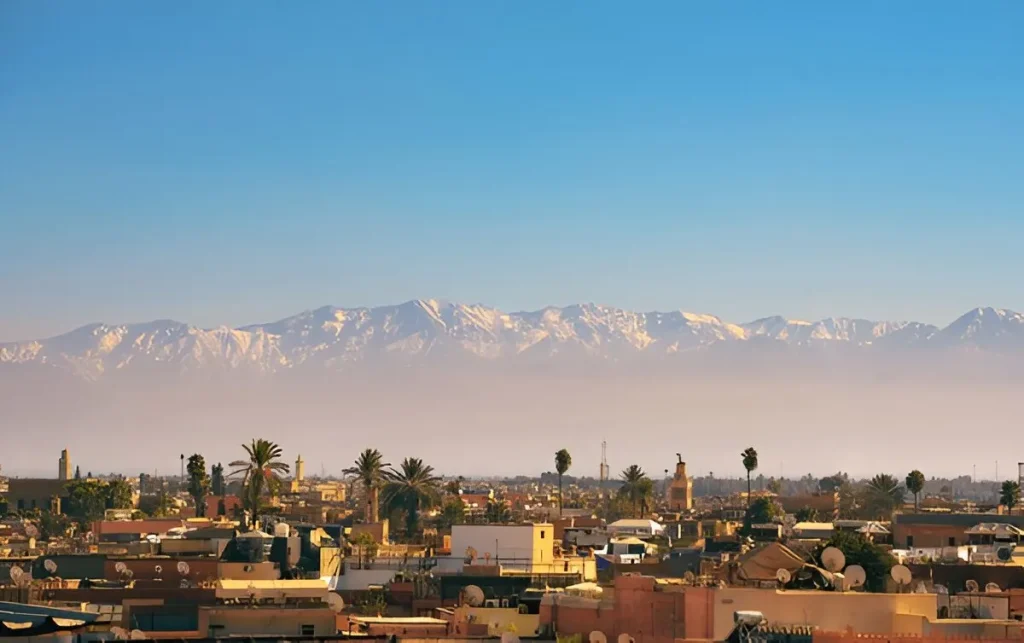
Just an hour’s drive from the vibrant streets of Marrakech, the Atlas Mountains rise like a majestic natural barrier, offering a refreshing escape from the city’s heat and hustle. Stretching across Morocco, Algeria, and Tunisia, these mountains are home to snow-capped peaks, lush valleys, ancient Berber villages, and some of the most breathtaking landscapes in North Africa. Whether you’re a seasoned adventurer or simply looking for a peaceful retreat, the Atlas Mountains provide an experience that blends natural beauty, cultural immersion, and outdoor exploration.
A Hiker’s Paradise
For those who love the great outdoors, the Atlas Mountains offer a vast network of scenic trails, ranging from gentle walks through fruit orchards and terraced fields to more challenging treks leading to the highest peak in North Africa—Mount Toubkal (4,167 meters). The climb to Toubkal’s summit is a bucket-list experience, rewarding trekkers with panoramic views that stretch as far as the Sahara Desert. For those seeking a less demanding but equally stunning trek, the Ourika Valley and Imlil Valley provide picturesque hiking routes that wind through lush greenery, flowing rivers, and rugged cliffs.
Berber Villages & Traditional Hospitality
One of the most enriching aspects of visiting the Atlas Mountains is the opportunity to connect with the Berber communities who have lived in these valleys for centuries. The Berbers, known as the Amazigh people, have preserved their unique language, customs, and traditions despite Morocco’s modernization. Visiting a traditional Berber village, such as those in Imlil, Aroumd, or Ouirgane, allows you to experience authentic mountain life, where families still rely on handcrafted tools, natural resources, and communal living.
Many local families welcome visitors into their homes, offering warm mint tea and homemade tagines cooked over open fires. Visiting these villages is one of the most authentic places to see in Marrakech, as it allows you to step into the daily lives of Berber communities. Sharing a meal in a Berber home isn’t just about the food—it’s about experiencing Moroccan hospitality at its purest, where conversations flow over cups of tea, and time seems to slow down in the quiet of the mountains.
Spectacular Landscapes & Hidden Valleys
The Atlas Mountains are not just about towering peaks; they also hold hidden valleys and dramatic landscapes that feel untouched by time. The Ourika Valley, with its rushing river and lush vegetation, is a popular day trip from Marrakech, especially for those looking to escape the summer heat. In Ouzoud, the Ouzoud Waterfalls, Morocco’s highest and most famous waterfalls, cascade down into a natural pool, where visitors can swim or take a traditional boat ride close to the falls.
For a more secluded experience, the Aït Bouguemez Valley, often referred to as the “Happy Valley,” is a hidden gem that offers stunning alpine scenery, traditional stone villages, and endless fields of wildflowers during the spring. Unlike the more tourist-heavy areas, this valley remains a peaceful sanctuary, perfect for those looking to disconnect from modern life.
Adventure & Outdoor Activities
Beyond hiking, the Atlas Mountains offer plenty of adventure for thrill-seekers. You can go mountain biking along rugged trails, horseback riding through the valleys, or even try rock climbing in the Todgha Gorge, a dramatic canyon known for its towering red cliffs. In the winter months, the Oukaïmeden Ski Resort, located at an altitude of 2,600 meters, transforms into a snow-covered paradise, where you can ski or snowboard with breathtaking mountain views—a rare and unexpected experience in Morocco.
A Journey into Nature & Culture
A trip to the Atlas Mountains isn’t just about adventure; it’s a chance to reconnect with nature and experience a way of life that remains deeply rooted in tradition. Whether you’re hiking through ancient cedar forests, sipping tea on a mountainside terrace, or watching the sun set over the valleys, this region leaves a lasting impression. It’s a place where the landscapes are as rich as the culture, and where every winding road, every village, and every mountain path has a story to tell.
Whether you’re looking for a peaceful retreat, a cultural experience, or a thrilling adventure, the Atlas Mountains stand out as one of the most breathtaking places to see in Marrakech. This majestic range offers a refreshing break from the city, inviting you to slow down, breathe in the crisp mountain air, and explore Morocco’s stunning natural wonders.
- Visit the beautiful village of Imlil, the gateway to Mount Toubkal.
- Experience a traditional Berber tea ceremony with a local family.
- Go trekking, horseback riding, or enjoy a scenic drive through the mountain roads.
Conclusion: Your Marrakech Adventure Awaits
Marrakech is a city that defies expectations at every turn—a place where ancient traditions and modern influences blend seamlessly, creating an atmosphere that is both timeless and ever-evolving. The moment you arrive, the energy of the city surrounds you. The scent of spices and fresh mint tea fills the air, the distant sound of drums and street musicians echoes through the alleyways, and the warm glow of lantern-lit courtyards invites you to step into a world where every corner tells a story.
What makes Marrakech truly special is its contrast between old and new, which is evident in the many places to see in Marrakech. In the heart of the Medina, life unfolds much as it has for centuries. You’ll see artisans meticulously crafting handmade leather goods, brass lanterns, and intricate carpets, using techniques passed down through generations. In the souks, shopkeepers call out playful invitations, inviting you to discover the treasures hidden within their stalls. The city’s historic palaces, mosques, and medersas transport you to an era of sultans and scholars, where intricate zellige tiles, cedarwood carvings, and grand courtyards speak to the craftsmanship of the past.
Yet, just beyond the Medina’s ancient walls, a different side of Marrakech emerges. The modern district of Gueliz is filled with chic cafés, designer boutiques, and contemporary art galleries that showcase Morocco’s growing creative scene. Rooftop lounges offer panoramic views of the Atlas Mountains, blending the skyline of historic minarets with the sleek silhouette of modern hotels. Luxury resorts and riads provide a sanctuary from the city’s vibrant chaos, where you can unwind in serene gardens, indulge in a traditional hammam, or sip cocktails by a candlelit pool.
No matter how you choose to explore Marrakech, every experience feels like a moment suspended in time. One minute, you’re winding through a labyrinth of alleys, watching a master calligrapher at work. The next, you’re in a contemporary art space, surrounded by bold, avant-garde paintings. You can find yourself bargaining for spices in the souks in the morning, and by afternoon, sipping tea in a garden once owned by Yves Saint Laurent. As night falls, the city transforms once again—the hum of Jemaa el-Fnaa comes alive, the scent of grilled meats and sweet pastries fills the square, and the hypnotic beats of Gnawa music pull you into an experience that feels both ancient and electric.
Marrakech is not a city you simply visit—it’s a city you feel. Every street, every courtyard, and every hidden riad holds a new discovery. Whether you’re here to immerse yourself in its rich history, indulge in its world-class hospitality, or simply lose yourself in its endless charm, Marrakech leaves an imprint on your soul—one that lingers long after you’ve gone.
Looking for personalized tours and custom holiday programs in Marrakech? Contact us today—it’s completely free!
What is the best time of year to visit Marrakech?
Marrakech is filled with incredible sights, but some of the must-visit places to see in Marrakech include Jemaa el-Fnaa, Bahia Palace, Majorelle Garden, Ben Youssef Madrasa, and El Badi Palace. Each location offers a unique blend of history, culture, and stunning architecture.
What is the best time of year to visit Marrakech?
The best time to explore the places to see in Marrakech is during spring (March-May) and autumn (September-November). During these months, the weather is pleasant, making it ideal for sightseeing, exploring the Medina, and taking day trips to the Atlas Mountains or Agafay Desert.
Are the souks in Marrakech worth visiting?
Absolutely! The souks of Marrakech are among the most fascinating places to see in Marrakech. They offer a vibrant mix of handcrafted goods, from leather bags and brass lanterns to intricate carpets and aromatic spices. It’s also the perfect place to experience the art of haggling and take home a unique souvenir.
Can you visit the Agafay Desert as a day trip from Marrakech?
Yes! The Agafay Desert is one of the most accessible places to see in Marrakech, located just 40 minutes away. Unlike the sand dunes of the Sahara, Agafay offers a stunning rocky desert landscape where you can ride camels, go quad biking, and even stay in luxury desert camps for an unforgettable evening under the stars.
What cultural etiquette should I be aware of when visiting Marrakech?
When exploring the places to see in Marrakech, it’s important to dress modestly, especially in religious sites. Greet locals with “Salam Alaikum” as a sign of respect, and always ask before taking photos of people. In markets, bargaining is expected, so don’t hesitate to negotiate prices in a friendly manner!
